Even a short list of amazing birds that start with E reveals how astonishingly adaptable and diverse these animals are. We so often see birds in our everyday lives that it’s easy to take them for granted and forget that there are species that live in all kinds of habitats and exhibit a dizzying array of behaviors. In this alphabetical sampling, you’ll find one of the world’s biggest birds and the world’s smallest bird of prey. You’ll see some species that might turn up in your backyard and one that lives in the harshest environment on earth. You’ll find a variety of body shapes, plumage colors, and behaviors. And hopefully, you’ll grade this list E: for educational, and entertaining!

Eagles (Accipitridae family)

The
Harpy Eagle
is the most powerful bird of prey in the world.
©Chepe Nicoli/Shutterstock.com
The strength and majesty of these large birds of prey have captured the human imagination throughout history. Civilizations from the ancient Babylonians to the Romans to the Aztecs have revered eagles as symbols of power, freedom, and divinity. Eagles are classified in the same family as hawks but are generally larger and more powerful birds.
The sixty or so species of eagles are sometimes grouped informally into four types. Serpent eagles feed on frogs, snakes, and lizards. Buzzard-like or harpy eagles are big enough to prey on large mammals like deer. Booted eagles have feathers growing down their legs and over their toes; this group includes the golden eagle, found worldwide. Sea eagles, including North America’s bald eagle, specialize in eating fish and water birds. Different eagle species have different body types to enable them to hunt effectively in their particular habitats. Eagles have some of the sharpest visual abilities of any animal. Some have five times as many light-sensitive cells in their eyes as humans and can see five basic colors compared to the three visible to the human eye.
Eagle Owl (Bubo bubo)

Eagle owls have tufted “ears,” like their American relative the great horned owl.
©LesPalenik/Shutterstock.com
Sometimes called the Eurasian eagle owl, this nocturnal hunter probably gets its name from its large size. They can be more than two feet long, with a wingspan of 4-6 feet, placing them among the largest owl species. They chiefly hunt rabbits but have been known to prey on deer, foxes, and even other raptors. Like other owls, they have excellent hearing and night vision and can fly silently, making them excellent hunters.
Earthcreepers (Furnariidae family)
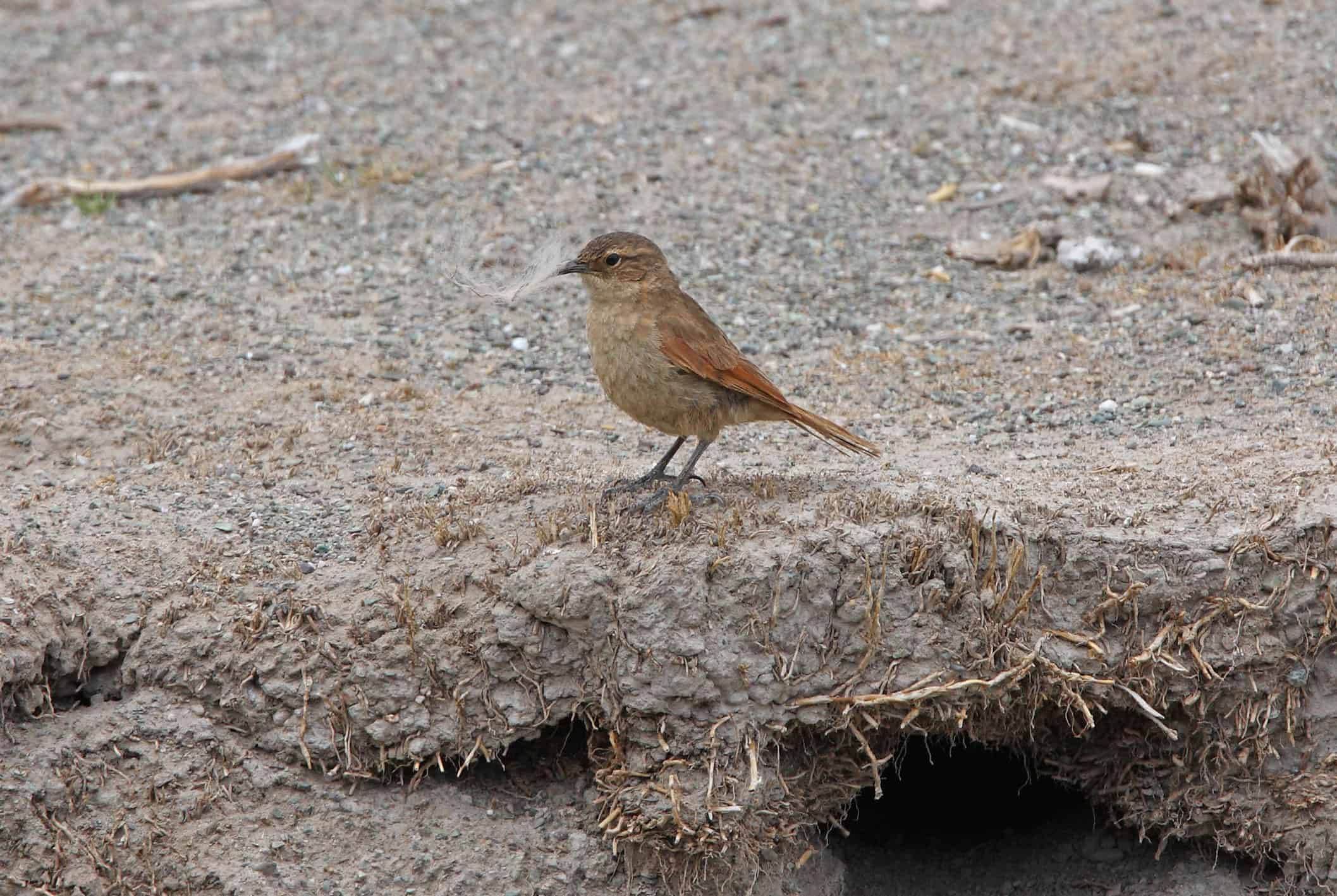
The species of earthcreepers are part of the ovenbird family, some of whom build chambered mud nests that resemble traditional wood-fired ovens.
©neil bowman/ via Getty Images
These unassuming little brownish birds are native to the western regions of South America, like Peru, Argentina, Bolivia, and Chile. The ten or so species of earthcreepers are part of the ovenbird family, a diverse group of insect-eating birds, some of whom build chambered mud nests that resemble traditional wood-fired ovens. Earthcreepers, as their name implies tend to be ground-foraging birds, though they’ll perch on shrubs or rocks. They can be difficult to tell apart, but some physical features differ between species, like the bill shape (curved or straight) or the presence of pale coloration on the throat or belly. The species names — rock earthcreeper, white-throated earthcreeper, band-tailed earthcreeper, and so on—tend to reflect their differentiating characteristics.
Eastern Bluebird (Sialia sialis)
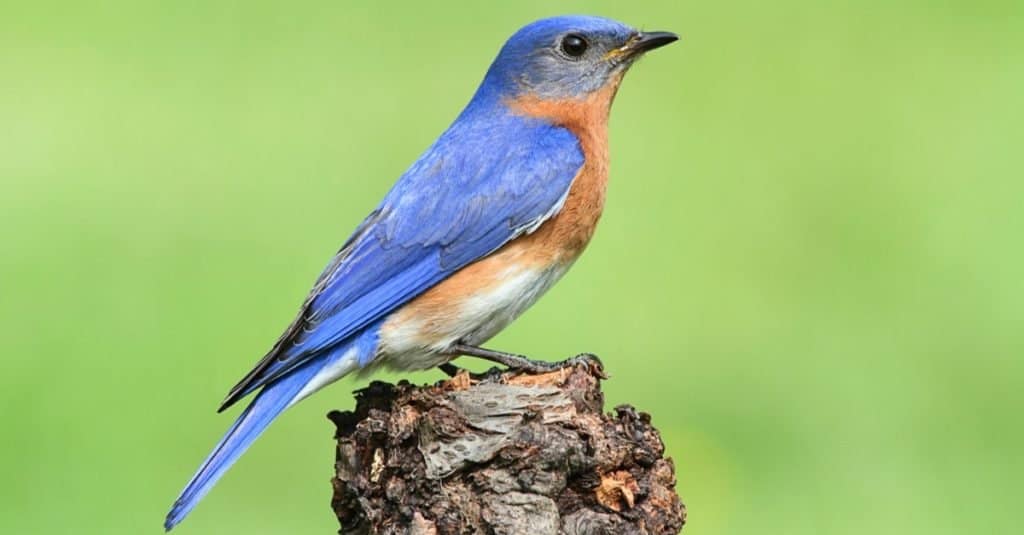
Bluebirds bring happiness to backyard birders.
©Steve Byland/Shutterstock.com
With its cheerful blue plumage that seems almost like something out of a fairy tale, the eastern bluebird is a welcome sight at any backyard bird feeder. These popular songbirds were in decline in the early 20th century, not only because of pesticide use and habitat loss, but because invasive species like starlings and house sparrows were taking over their nests. Fortunately, bluebirds will make themselves at home in artificial nest boxes. This and other conservation strategies have turned things around for one of North America’s most beloved birds.
Edible Nest Swiftlet (Aerodramus fuciphagus)
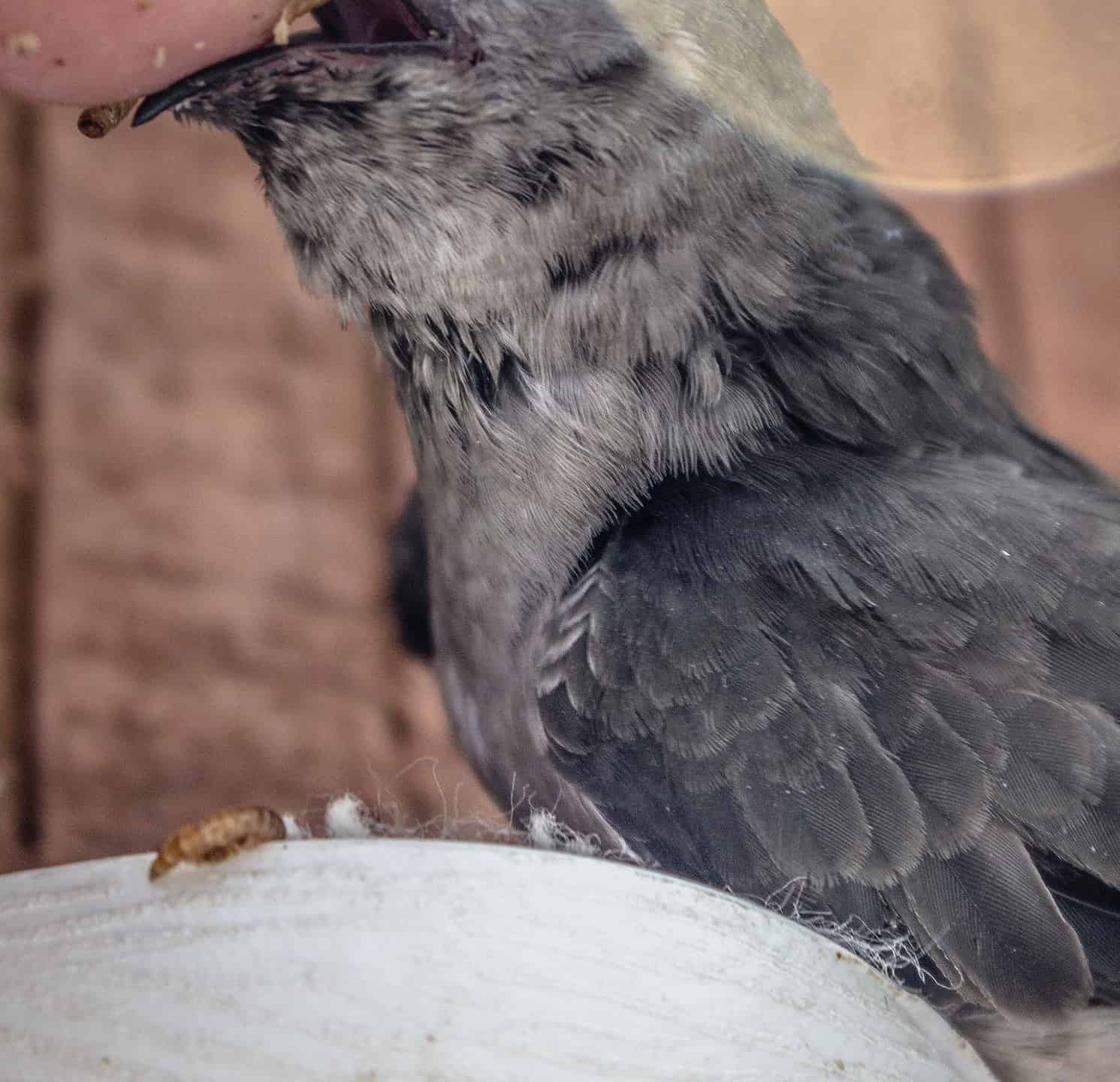
The edible-nest swiftlet, also known as the white-nest swiftlet, is a small bird of the swift family which is found in Southeast Asia.
©mletruc/ via Getty Images
Also known as the white-nest swiftlet, this bird shares similarities with a number of related species, including its size and coloration, and its habitat in caves in southern Asia. A point of distinction, though, is that the edible nest swiftlet is the source of bird’s nest soup, a delicacy of Chinese cuisine. If you’ve never had the pleasure, you may or may not want to know that swiftlets make their nests not of sticks and twigs, but out of their own hardened saliva. The hammock-like nest is gently steamed to form a gelatinous soup base and flavored with sugar or milk.
Egrets (Egretta spp. and others)
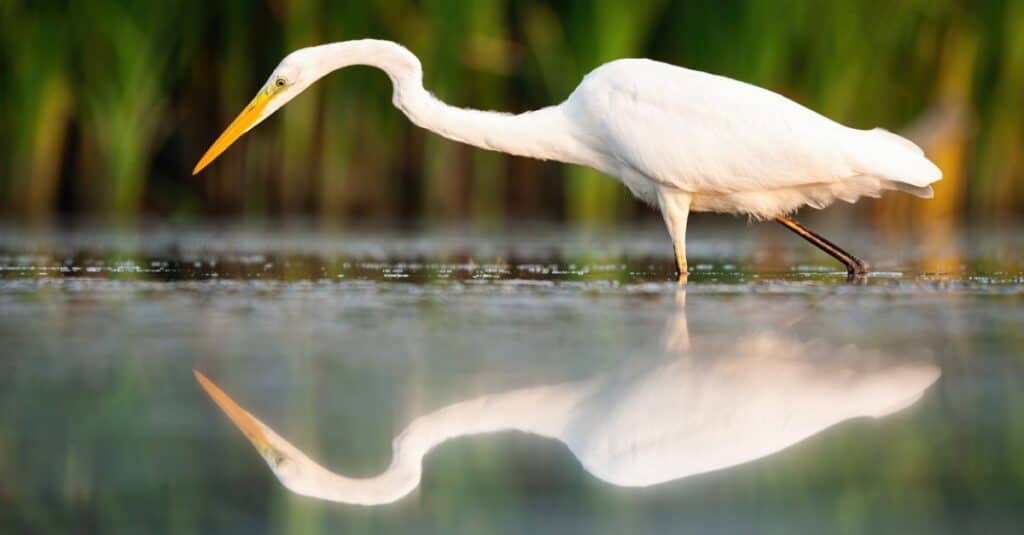
An elegant neck with an S-curve is the sign of an egret.
©WildMedia/Shutterstock.com
These wading birds are part of the heron family, though the distinction between herons and egrets is more about language than biology. Egrets tend to be white in color, though not all are. Most species, like the great egret, have remarkably long necks and spear-like bills to catch their aquatic prey. Then again, consider the more compact, shorter-necked cattle egret, which feeds on ticks and insects found on or near grazing mammals. Egrets and herons will hold their necks in a curved, s-like shape, and they fly with their necks pulled in. That’s one way to distinguish them from cranes and storks, who keep their long necks extended when they fly.
Elf Owl (Micrathene whitneyi)
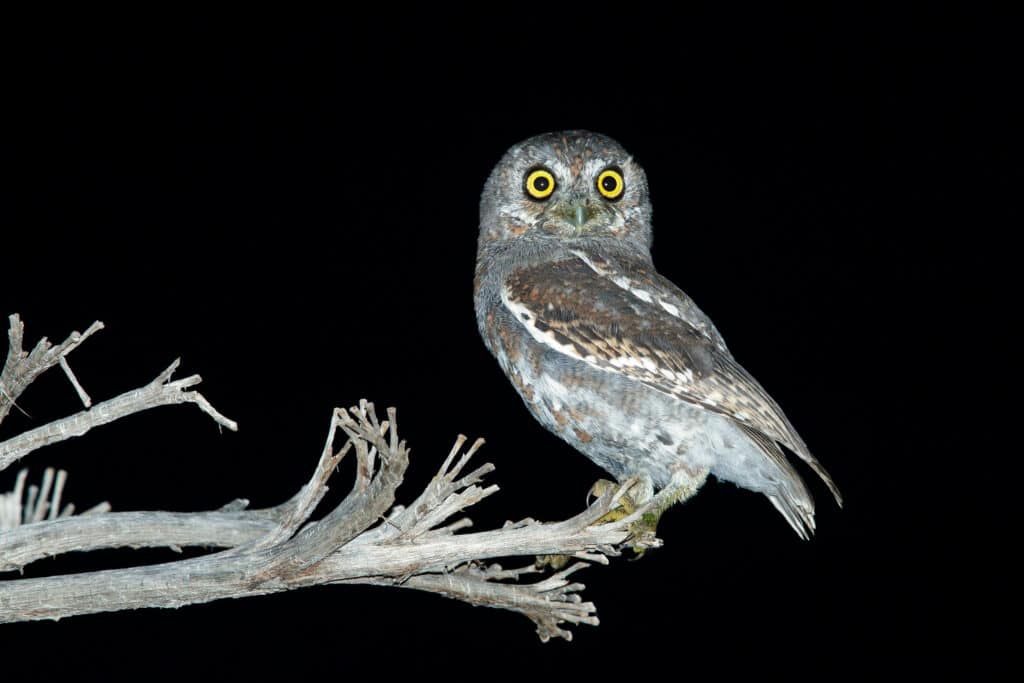
Who’s the smallest owl of all?
©Agami Photo Agency/Shutterstock.com
About the size of a robin, elf owls top out at 5.5 inches tall, which makes them the world’s teensiest birds of prey. They mostly eat insects and spiders but, remarkably, elf owls will sometimes capture small snakes and bring them back to their nests, where the snakes will eat harmful parasites. Like all owls, they’re nocturnal hunters. Sometimes they’ll go after insects that are attracted to outdoor lights at night.
Emperor Penguin (Aptenodytes forsteri): Most Endangered Bird that Starts with E
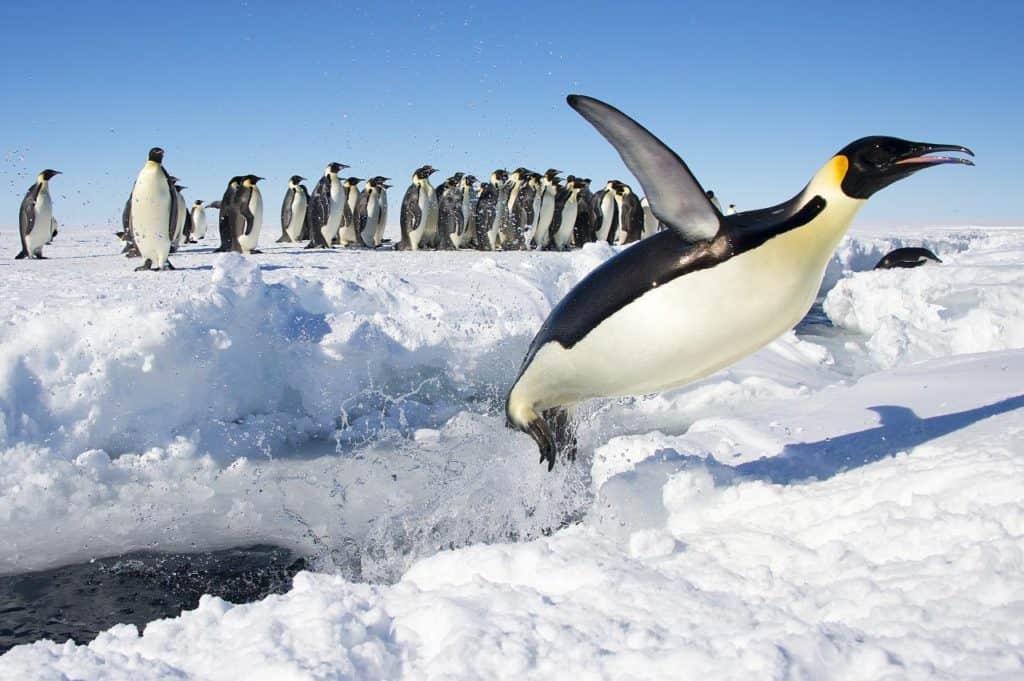
Well adapted for antarctic living, emperor penguins are threatened by climate change.
©Christopher Michel / CC BY 2.0, Flickr – License
The largest species of penguin, emperors may be the only birds that never set foot on land, spending all their lives on frozen sea ice as they do. They can survive in one of the harshest environments on earth thanks to dense layers of feathers and large fat reserves to prevent heat loss. Huddling together also keeps them warm. They’re not just swimmers, they’re excellent swimmers, able to dive deeper and stay underwater longer than any bird. Despite their amazing adaptations, emperor penguins are endangered by climate change that’s shrinking their sea ice habitat. In 2022, they were listed as a threatened species under the Endangered Species Act.
Emu (Dromaius novaehollandiae): Largest Bird that Starts with E
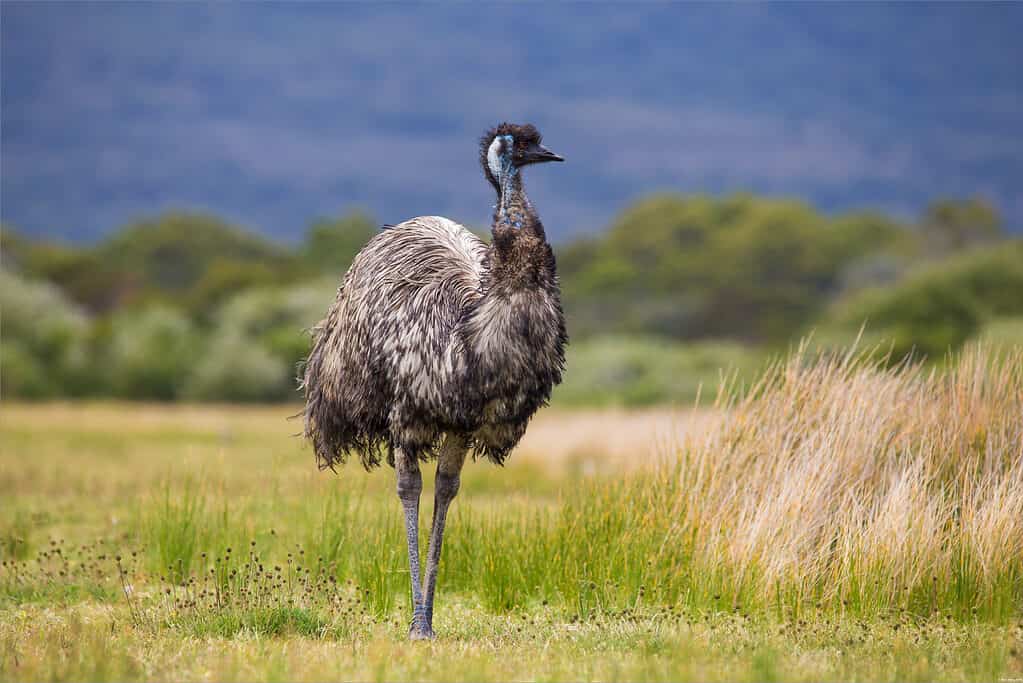
On the move: emus migrate to find food and water.
©colacat/Shutterstock.com
Second only to ostriches in size, emus are widespread in their native Australia, where they benefit from watering points established for cattle and sheep grazing. Emus need fresh water daily and will migrate for hundreds of miles to find it, following rain clouds to areas where food and water are more abundant. During their migrations, emus help various plant species to disperse, because seeds of the plants they eat get left behind in their droppings. Emus are flightless, but fast runners who can reach speeds of 31 mph, and strong swimmers too.
European Starling (Sturnus vulgaris): The Most Controversial Bird that Starts with E
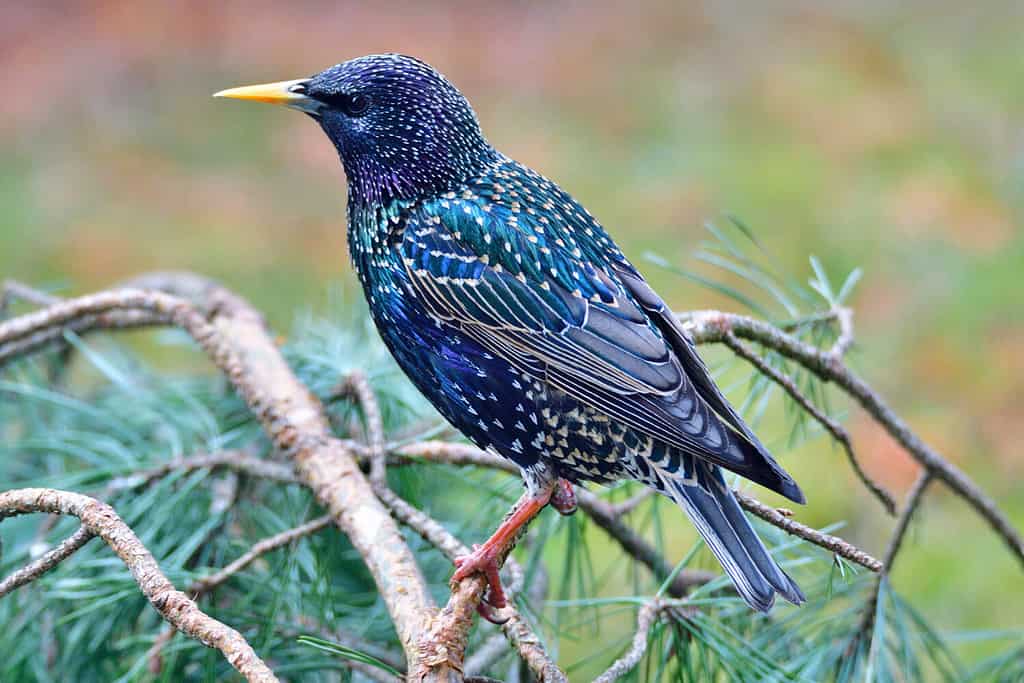
Seeing starlings: the success of these familiar birds rubs some people the wrong way.
©Karin Jaehne/Shutterstock.com
You probably just call this familiar bird a “starling,” but its geographical origin points to the bird’s amazing success as transplants to North America. An often-repeated story that all U.S. starlings are descendants of a mall group released by a Shakespeare enthusiast in 1890 has been debunked. But records do suggest that wild populations were establishing themselves in the 19th century. And since then they’ve spread across the entire continent, from sea to sea and from Canada to Mexico. Some say starlings are too successful. They’ve been labeled as pets who displace native birds, spread disease to livestock, and descend on people’s backyards in noisy, messy flocks. But starlings are here to stay, so there’s no harm in admiring their speckled, iridescent plumage, or the acrobatic wheeling of their flocks across the sky.
Summary of Birds that Start with E
| Ten Amazing Birds that Start with E | Bird that Starts with E | Scientific Name |
|---|---|---|
| 1 | Eagle | Accipitridae family |
| 2 | Eagle Owl | Bubo bubo |
| 3 | Earthcreeper | Furnariidae family |
| 4 | Eastern Bluebird | Sialia sialis |
| 5 | Edible Nest Swiftlet | Aerodramus fuciphagus |
| 6 | Egret | Egretta and other spp. |
| 7 | Elf Owl | Micrathene whitneyi |
| 8 | Emperor Penguin | Aptenodytes forsteri |
| 9 | Emu | Dromaius novaehollandiae |
| 10 | European Starling | Sturnus vulgaris |
The photo featured at the top of this post is © Banu R/Shutterstock.com
Thank you for reading! Have some feedback for us? Contact the AZ Animals editorial team.







